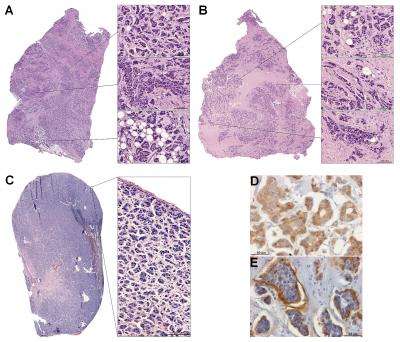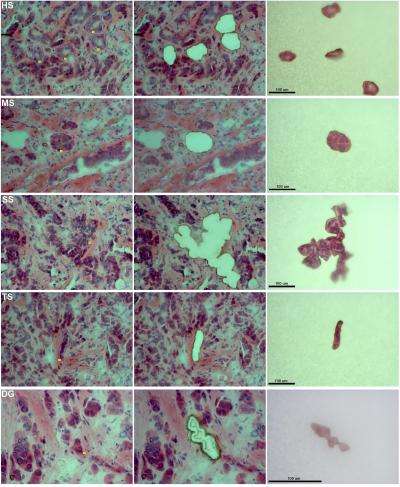Intratumor morphological heterogeneity of cancer is not related to chromosome aberrations

Intratumor morphological heterogeneity (diversity) of breast cancer is not related to chromosome aberrations. This conclusion was made based on a study by researchers from Tomsk State University (TSU), Tomsk Cancer Research Institute (TCRI), and the Institute of Medical Genetics of one case with an aggressive variant of breast cancer—invasive micropapillary carcinoma. The research has been published in Journal of Clinical Pathology June 15, 2015. The investigation was led by Vladimir Perelmuter, MD, PhD, Head of the Department of Pathological Anatomy and Cytology and Nadezhda Cherdyntseva, PhD, Head of the Laboratory of Molecular Oncology and Immunology.
Breast cancer demonstrates a significant intratumor morphological heterogeneity represented by five types of morphological structures reflecting different architectural patterns of tumor cells—tubular (hollow-like), alveolar (morula-like), solid, trabecular structures, and discrete groups of tumor cells. Such heterogeneity has been found to contribute to chemotherapy efficiency and metastasis. Patients with either alveolar or trabecular structures in tumors demonstrate poor response to neoadjuvant chemotherapy. In addition, breast tumors containing alveolar structures more often metastasize to the lymph nodes.
To understand whether intratumor morphological heterogeneity in breast cancer is determined by genetic alterations, Dr. Evgeny Denisov (Postdoc at TSU and Senior researcher at TCRI) and colleagues investigated the spectrum of chromosome aberrations in different morphological structures obtained from two distinct regions of one breast tumor.
"We compared different structures with each other by the spectrum of chromosome aberrations," Dr. Evgeny Denisov said. "We wanted to know if these structures have different chromosome abnormalities, and yes, we found different chromosomal aberrations. Then, we tried to understand if there are any unique mutations in distinct structures; for example, the ones in alveolar structures, which result in the formation of these groups of tumor cells. However, the results of our study showed that there are no chromosome mutations specific for different morphological structures. This data allows us to conclude that intratumor morphological heterogeneity of breast cancer is not related to chromosome aberrations."

To obtain these results, researchers used two samples of the primary tumor from a patient with an aggressive form of breast cancer, invasive micropapillary carcinoma, which shows high intratumoral morphological diversity. Five types of different morphological structures were obtained from each tumor sample using laser microdissection, which allows the isolation of pure tumor cell populations without admixture of adjacent non-tumor stroma cells. DNA samples were prepared from each sampled morphological structure and used for the identification of chromosome aberrations by comparative genomic hybridization-based microarrays.
"It was also very interesting for us to understand the descendants of which morphological structures compose lymph node metastases, since we have previous data regarding the association of alveolar structures with lymph node involvement," said Dr. Denisov. "That is, we would like to make sure that only tumor cells from alveolar structures metastasize to lymph nodes. If so, then alveolar structures should be more similar with lymph node metastases in the spectrum of chromosome aberrations than other structures".
Thus, metastatic cells were isolated from lymph node of the studied breast cancer case, analyzed for chromosome abnormalities, and compared with each structure from each tumor region in genetic portrait. It turns out that only solid structures (but not alveolar) from the second tumor region had the greatest similarity with lymph node metastases in common chromosome aberrations. It turns out that lymph node metastases were the descendants of these solid structures. However, it is unknown whether this relationship holds for other breast cancer cases or how to explain the association of alveolar structures with lymph node metastases. Future studies should be performed to confirm or refute the obtained data.

The team performed whole transcriptome profiling of different morphological structures of three breast cancers and found specific genes contributed to the formation of each type of structure. In addition, they were able to identify genes involved in the above mentioned contribution of morphological structures to breast cancer metastasis and chemotherapy response (the paper is prepared for publication).
"At present, it is not clear what factors regulate differential gene expression in different morphological structures," Dr. Denisov said. "We are planning to identify these regulators, which provoke tumor cells to form different structures."
Researchers hope to identify targets specific for aggressive morphological structures (e.g. alveolar and trabecular) and to develop new treatment strategies focused on their elimination. To destroy these structures in breast tumors, it is possible that increasing chemosensitivity could decrease tumor metastasis risk.

















